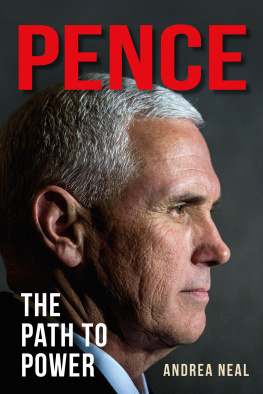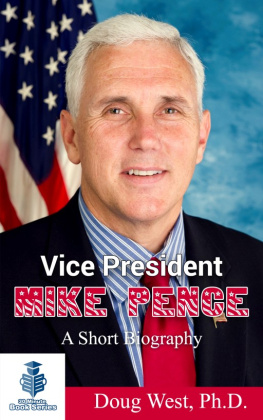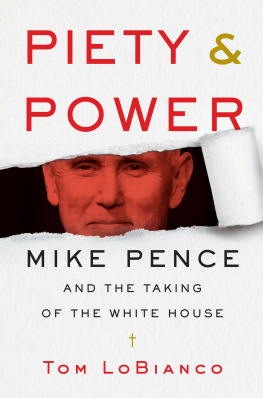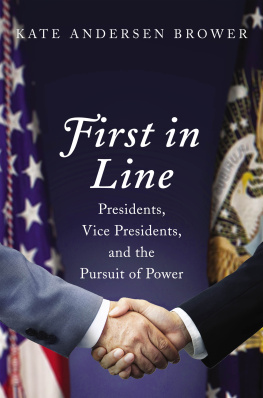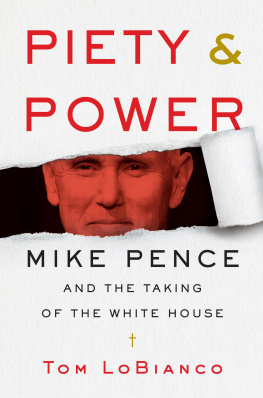
PENCE

PENCE
THE PATH TO POWER

ANDREA NEAL

This book is a publication of
Red Lightning Books
1320 East 10th Street
Bloomington, Indiana 47405 USA
redlightningbooks.com
2018 by Andrea Neal
All rights reserved
No part of this book may be reproduced or utilized in any form or by any means, electronic or mechanical, including photocopying and recording, or by any information storage and retrieval system, without permission in writing from the publisher.
The paper used in this publication meets the minimum requirements of the American National Standard for Information SciencesPermanence of Paper for Printed Library Materials, ANSI Z39.48-1992.
Manufactured in the United States of America
ISBN 978-1-68435-037-7 (cloth)
ISBN 978-1-68435-040-7 (ebook)
1 2 3 4 5 2322 21 20 19 18
For
GEORGIANNE DAVIS NEAL,
my mother and editor-in-chief
CONTENTS
PREFACE
THIS BOOK BEGAN DURING A LONG-ANTICIPATED DRIVE from Indianapolis to Chicago to see the hit musical Hamilton. I was on spring break from St. Richards Episcopal School, where I have the privilege of teaching sixth graders the rules of English grammar and eighth graders the founding ideals of our republic. I answered my cell phone somewhere north of Lafayette and was greeted by Ashley Runyon, an editor at Indiana University Press. Would you be interested in writing a famous Hoosiers biography? she asked. Yes, I said, imagining the possibilities: Civil War governor Oliver P. Morton; Virginia Jenckes, the states first female member of Congress; Miami chief Little Turtle, known for inflicting one of the worst defeats in US military history; or songwriter Hoagy Carmichael of Stardust fame. I had gotten to know all four of these intriguing figures during my research for the book Road Trip: A Pocket History of Indiana published for the states bicentennial in 2016.
As it turned out, Runyon had a more contemporary figure in mind: the newly elected vice president of the United States, Michael R. Pence. Her keen editors eye recognized the historic import of a sixth Hoosier vice president but also the relevance of his Indiana roots and upbringing. This would be an altogether different challenge. How does one write a biography of a public figure while news about him is still being made? How could I put into context a member of the unpredictable Trump White House with all of its pitfalls, peccadillos, and chaotic management style? There would be an ever-present risk of daily news superseding my efforts to write a complete biography.
The solution was to tell the story of Mike Pences path to the vice presidency, with a focus on the events leading up to the day he took the oath of office in January 2017. This book, therefore, follows Pences life through a decidedly Hoosier lens made possible by forty-five interview subjectsfriends, political advisers, and adversarieswho shared with me the stories of their various and varied relationships with the vice president. I am especially indebted to Jeff Cardwell, Jay Steger, Rex Early, and Jim Atterholt, who gave up many hours of their busy lives to meet with me. I am also grateful to have spent time with the Columbus Republics legendary editor Harry McCawley, who died in September 2017 of cancer. Although Vice President Pence declined my request for an interview, the past thirty years of his life have been spent in the public spotlight, so there was no shortage of public record or primary source material.
Early in the process, I committed to using named sources only, the journalistic practice my bosses insisted on in the 1980s and 90s when I was a reporter for United Press International and the Indianapolis Star. As a result, the book omits a few headline stories reported by the Beltway press but never verified. My research confirmed my fear that anonymous accounts, which tend to be unreliable, are the first cousin of fake news. As just one example, a prominent magazine reported that Paul Manafort made up the story of a flat tire on Trumps campaign airplane in July 2016 to keep the candidate in Indianapolis long enough to develop a rapport with Indianas governor. This assertion, attributed to two anonymous former Trump aides, was debunked by the motorcade driver I interviewed who spotted the flat tire and reported it to Secret Service. The magazines mistake brought to mind a long-standing family joke about true facts, which I hope to be the only kind found here. To that end, all original research has a footnote attached, as do quotations drawn from the hundreds of newspaper articles and other publications that informed my research.
Post-inaugural events and analysis are confined to the epilogue, which concludes, based on a single years worth of evidence, that Pence is a player with substantial influence in the Trump administration. He is the only one who cannot be fired by virtue of his constitutional office, and that in itself gives him power. A more definitive conclusion must await future historians who will have, as Paul Harvey used to say, the rest of the story.
INTRODUCTION
AND THEN THERES ME
LIKE THE YELLOW BRICK ROAD IN HIS FAVORITE MOVIE, MIKE Pences path to power has followed a singular, if sometimes elusive, goal. And it began when he was just a teenager and even then a candidate. Longtime friends and teachers remember with surprising unanimity young Pences frequent announcements of his political intentions. It is a quest that has never faltered, made stronger by his years at Hanover College, where he studied under the illustrious G. M. Curtis, and his marriage to Karen, who has supported her husband in every run for office. The influence of his Indiana experience is a large part of his public persona, as is the self-deprecating humor that Pence expressed often on the campaign trail, a tactic particularly effective when comparing himself to the flamboyant Donald Trump: Hes bigger than life. Always memorable. Charismatic. And then theres me.
Pence is a paradox to those who admire him and those who donthumble (his all-purpose adjective) yet confident, ultraconservative yet willing when necessary to smooth out the most glaring rough edges. In his own words, he has staked out three positions that have defined his core beliefs: Christian, conservative, and Republican, in that order. It is a combination that has worked so far and weathered an avalanche of criticism, including the contradictory charges that he is either Donald
To seasoned political observers, Pences selection as vice president carried echoes of New Orleans in 1988 when George H. W. Bush startled the Republican faithful by naming Indianas junior senator Dan Quayle as his running mate. The coincidence was a second surprise from the heartland as the candidates, both Hoosiers with limited name recognition, became household words overnight. The first clue was the Trump entourage convening in Indianas highly visible governors mansion, but there were others. Like Quayle, Pence had an already developed voter base, which, though small, was dedicated and supportive throughout his campaigns. Unlike Quayle, who ran in tandem with one of his partys most admired and experienced figures, Pence came loaded with a basket of desirables that Donald Trump badly needed. Pences appearance was appropriately vice presidential, allegedly prompting an ecstatic Trump to exclaim, Isnt he just perfect? Straight from central casting. Cartoonists, too, were quick to seize the vice presidents pictorial possibilities, developing almost immediately a comic portfolio showing the vice president being sprayed with Teflon or dutifully following behind Trump with a shovel.
Next page
